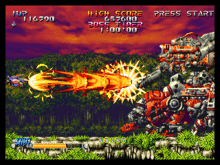Blazing Star
| Blazing Star | |
|---|---|
 | |
| Developer(s) | Yumekobo |
| Publisher(s) | SNK |
| Designer(s) | SNK |
| Composer(s) |
Harumi Fujita Seisuke Ito |
| Platform(s) | Arcade, Neo Geo, iOS, Android |
| Release date(s) | 1998-02-19 |
| Genre(s) | Shoot 'em up |
| Mode(s) | Single-player, Multiplayer |
Blazing Star (ブレイジングスター) is a scrolling shooter video game for the Neo Geo home game system. It is the sequel to Pulstar, which was itself a close cousin to the R-Type franchise. A typically hefty Neo Geo ROM at 346 Mb, the game makes extensive use of pseudo-3D prerendered sprites, brief anime and CGI cutscenes (mostly during the intro sequence), and frequent Engrish voice samples and captions.
Story
Sometime in their past, the planets Remuria and Mutras started an interplanetary war that showed no sign of ending. The endless fight between the human-like inhabitants of the two planets had gone so long that weapon development moved into dangerous territory: Organic Weapon Production combined with alien technology. Soon, a sentient weapon - Brawshella - was born. Brawshella gathered all animal life on both planets and forced them to do its bidding and attack the humans. In a week, the humans were assimilated by Brawshella.
Yet, once they were assimilated, they found no other purpose in life but to continue fighting each other. After a while, six of the assimilated fighter pilots regained their consciousness and remembered their pasts. Upon discovering their humanity, the pilots were conflicted with following Brawshella's orders or fighting it to fully regain their independence. The pilots finally turn against the machine in a battle to rediscover themselves and reclaim their planets.
Gameplay

The joystick and two buttons are used to play Blazing Star. The joystick moves the ship around, while button A fires the normal shot. If A is tapped rapidly, then a variation on the normal shot is used. If A is held down, then the ship stores energy for a charged shot, which is fired when A is released. The charged-shot attacks have a duration based on how long the A button is held for, and pressing B during the attack will split the projectile in some way, greatly increasing the range.
Power-ups can increase the strength of the player's guns, while also increasing the maximum power of the charged shot. The types of shots, charge-up attacks, and split shots used are dependent on the ship the player selects. For instance, the ship seen in the screenshot above has small energy waves as its normal shot. The charged shot, seen in action here, releases a continuous stream of large fireballs. By pressing B, every fireball onscreen splits into numerous smaller shots, spreading to cover a much wider range.
Internet culture
According to an August 7, 2009 The New York Times article by Ben Zimmer, the popular expression FAIL came from this game: "This punchy stand-alone fail most likely originated as a shortened form of “You fail” or, more fully, “You fail it,” the taunting “game over” message in the late-’90s Japanese video game Blazing Star, notorious for its fractured English."[1] The full "game over" message is "You fail it! Your skill is not enough, see you next time, bye-bye!"
References
- ↑ Zimmer, Ben (2009-08-07). "ON LANGUAGE - How Fail Went From Verb to Interjection". The New York Times. Retrieved 2012-06-20.